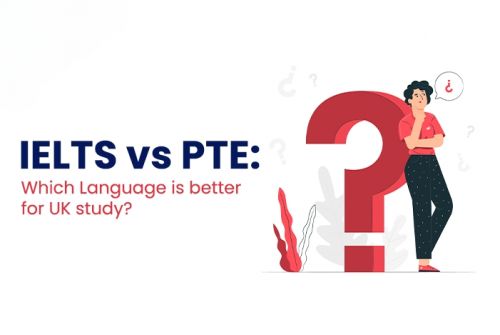
IELTS vs PTE:
Which language is better for UK study?

IELTS (International English Language Testing System) is a widely accepted English proficiency exam used for education, work, and immigration purposes in countries like the UK, Australia, and Canada. It tests listening, reading, writing, and speaking, with options for paper-based or computer-based formats. The speaking section involves a face-to-face interview, giving candidates a real-time communication experience.
PTE (Pearson Test of English) is a fully computerized test that assesses English proficiency in listening, reading, writing, and speaking. Known for its fast results, usually within 48 hours, it uses an automated scoring system for unbiased results. PTE is accepted by universities and governments, especially in Australia and New Zealand, and is ideal for those who prefer computer-based testing.
IELTS offers two versions—Academic and General. Academic is for student visas, while General is for immigration and residency. PTE Academic is widely accepted for both purposes, particularly in Australia and New Zealand. Over 11,500 universities recognize IELTS, while 3,000 institutions accept PTE.
The British Council and IDP conduct IELTS, which can be registered online or offline. Pearson runs PTE, which requires online registration only. Both tests are conducted at authorized centers globally.
IELTS scores take up to 13 days for the paper version and 3-5 days for the computer version. PTE scores are faster, typically available within 48 hours, making it ideal for those needing quick results.
IELTS scores are given on a scale from 0 to 9 for each skill, with an average overall score. PTE scores range from 10 to 90, with separate scores for key communication aspects, offering a more detailed breakdown.
PTE is considered easier by many, with a focus on practical language use. IELTS is often seen as more challenging, requiring a deep understanding of grammar and pronunciation. Both, however, assess adaptability in an English-speaking environment.
The IELTS and PTE exams assess the English language skills across various sections, but their formats differ.
Both exams assess the same skills but use different methods, catering to various learning styles and preferences.
A Guide to Study in UK without IELTS
Here is descriptive information on the comparison of IELTS and PTE:
| Exam | Test Duration | Score Range | Recommended Score | Proficiency Levels |
|---|---|---|---|---|
| IELTS | Approx. 2 hours 45 minutes | 0 – 9 bands | 6.5+ for most universities and visa programs | 0 – Did not attempt 1-4 – Limited user 5-8 – Modest to very good user 9 – Expert user |
| PTE | Approx. 3 hours | 10 – 90 points | 65+ for strong visa and admission chances | 10-29 – A1 Beginner 30-42 – A2 Elementary 43-58 – B1 Intermediate 59-75 – B2 Upper-Intermediate 76-84 – C1 Advanced 85-90 – C2 Expert |
This comparison helps students identify which test aligns better with their language proficiency goals and the requirements of their desired institution or immigration pathway.
Both IELTS and PTE measure your ability to understand and use English effectively. They assess fundamental language skills necessary for academic, professional, and immigration purposes.
Both exams test the same four essential language skills: reading, writing , and listening, ensuring a comprehensive evaluation of your English proficiency.
Both IELTS and PTE allow the use of UK and US English. IELTS offers both paper-based and computer-based options, while PTE has always been computer-based, catering to different preferences.
Both tests employ detailed scoring systems to assess your performance in each section, providing a clear overview of your proficiency in English.
IELTS and PTE are both widely recognized by universities, employers, and immigration authorities worldwide, making them essential qualifications for study, work, or migration.
These commonalities highlight their shared focus on providing a reliable measure of English Language skills for global use.
If you’re applying for a student visa to the UK, IELTS is the most reliable and widely accepted English proficiency test. Recognized by all UK universities, IELTS Academic is specifically designed to assess your readiness for an English-speaking academic environment. Its focus on real-world English skills—listening, reading, writing, and speaking —ensures that students can effectively communicate and succeed in UK institutions.
Additionally, the test is accepted by UK Visas and Immigration (UKVI), making it a trusted option for visa applications. Choosing IELTS for your UK student visa provides a seamless, trusted path to studying in one of the world’s leading academic destinations.
When deciding between IELTS and PTE, especially for the UK, it’s essential to understand the key differences and similarities of both tests. IELTS, with its Academic and General versions, is the preferred choice for those applying for a UK student visa or permanent residency, due to its widespread acceptance by UK universities, employers, and immigration authorities. Its focus on face-to-face speaking tests and real-world English skills makes it highly suited for adapting to life in the UK. On the other hand, PTE is ideal for those seeking quicker results with its fully computerized format, although it may not have the same level of recognition in the UK as IELTS.
Both tests evaluate listening, reading, writing, and speaking skills, with IELTS offering both paper-based and computer-based formats, while PTE is entirely computer-based. When considering factors like score availability, testing preferences, and global recognition, IELTS often emerges as the more versatile option for those targeting the UK.
With “Bizz Education” by your side, you can confidently navigate your English proficiency test and visa process. Bizz Education provides expert guidance on choosing the best test for your goals, whether IELTS or PTE, and offers comprehensive preparation to help you achieve the best scores. They ensure you’re ready to meet the language requirements and pursue your UK dream with ease, making them an invaluable partner in your journey.